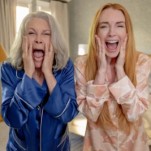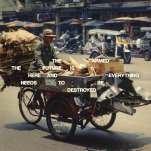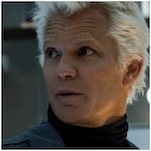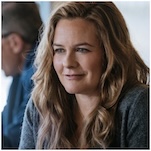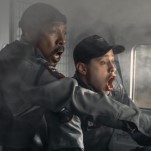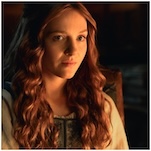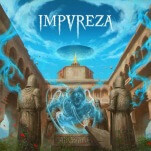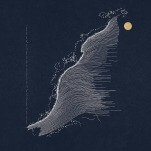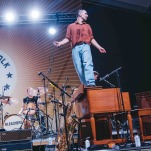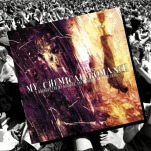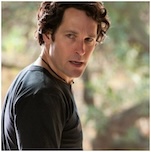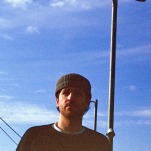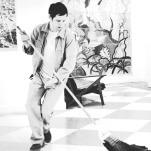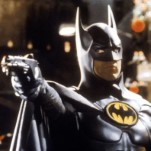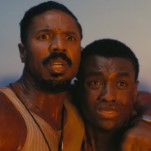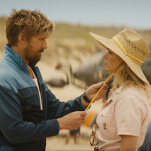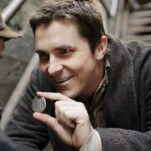Florence Welch’s Big, Blue, Beautiful Recipe for Success
From the way her majestic voice billows up with cathedral command in performance, through her diaphanous, swirling stage dresses and paisley-colorful, frequently photographed offstage outfits, down to the simple beauty of the way her flowing red mane accents her angular, porcelain-hued facial features, there’s just something, well, regal about Florence Welch—something almost Renaissance-classic, or perhaps time-warped in from a black-and-white G.W. Pabst era when film stars were larger than life and truly filled up the screen. From the beginning, that rare, ephemeral quality was there in the grooves of Lungs, her Brit-Award-winning 2009 debut, and in her more ornate, Grammy-nominated followup in 2011, Ceremonials.
The same vibe was also evident in Welch’s recent appearance on NBC’s Saturday Night Live, where, hobbled by a broken foot she sustained at this year’s Coachella festival, she remained anchored to a stool to perform songs from her new effort, How Big How Blue How Beautiful, yet still managed to rattle every last rafter and bring the house down. At only 28, the woman is already rock royalty. But even queens can experience some bad days—or months, as this singer did in her struggle to complete the initially Sisyphus-strenuous new album. But, with producers Markus Dravs and Paul Epworth, she eventually arrived at perfection, in tracks like the stomping “Third Eye” (in which she urges herself to “Look up, you don’t have to be a ghost here among the living”); the organ-pneumatic processional “St. Jude” (which finds her praying to the saint of lost causes); the galloping “Queen of Peace”; the sincerity-questioning anthem “What Kind of Man” and anvil-chorus “Ship to Wreck,” where she uses a vessel as metaphor for her career (“Did I drink too much, am I losing touch?/ Did I build this ship to wreck?”). These are the 10 ingredients that went into it.
1) A weathered old anorak
Welch—who has become a favorite of design houses like Chanel—is usually stalked by paparazzi everywhere she goes in her native London. But she swears she hasn’t been intrusively snapped for over a year, thanks to her decision to forego fashion in favor of slipping on a Mod-vintage parka and bicycling to daily studio sessions. And with her trademark tresses hidden beneath a hood, she was never recognized on the street. Not once. “It was really insular, a quiet time away from the public eye,” she recalls of her period of anonymity. “When I was making the record, clothes were the last thing on my mind—all I was thinking about was getting to the studio and making this thing, making this album. It was almost like being a weird monk—I just wore the same thing every day, I made a packed lunch, and I cycled to work. It was really simple, for the first time in a long time.”
2) Disconnecting from celebrity itself
The stylish, articulate Welch had become an A-list party guest. And for a while, she relished the privilege. She saw it as a fun obligation, part and parcel of the lofty rock lifestyle. But she wound up, she sighs, “crying all the time—it was almost like, ‘Oh. This isn’t working for me anymore.’ It didn’t make sense to me anymore, so I needed to just take some time away and deal with whatever was going on. I wanted to find out what actually made me happy, and I was supposed to have this relaxing year off.” It didn’t work out that way for her, exactly.
3) A year spent abroad
Welch decided to reward herself with travel. Perhaps the road would reward her with the new material she sought. She visited Jamaica and spent time writing in Los Angeles, as well. “But I was still on-and-off partying, and I was in an on-and-off relationship,” she says. “So things were pretty up and down while I was writing this record, and there were a lot of highs and lows. So it was a time of great excitement, and a time of real lows, as well.” She was purposely going on a journey, and the record is a map of her travels. “And if you really wanted to, I guess you could figure out a lot of the places I went—there are little clues all the way through it,” she adds.
4) Being alone with herself in the rambling new digs she purchased
On tour, Welch was always surrounded by the roughly 20 people who comprise her band The Machine and its crew. At the family estate where she resided until recently, there were eight folks around, and the clan regularly convened for intellectual conversation at dinner (her mother is an art professor who believes in God; her stepfather is an atheism-espousing virologist, always making for some stimulating conversation). “So I moved into this house, and it was a total shock to the system,” she confesses. “But it really was a catalyst. It made me have to learn how to look after myself, like, ‘Oh. I have to sit with these feelings!’ It made me start meditating, start wanting to read and maybe not go out. So I started transcendental meditation, and that’s been really helpful. It made me learn how to nurture myself more, to try and look after myself a bit.”
5) An eye-opening moment when everything caved in, inspiring “Ship to Wreck”
-

-

-

-

-

-

-

-

-

-

-

-

-

-

-

-

-

-

-

-

-

-

-

-

-

-

-

-

-

-

-

-

-

-

-

-

-

-

-

-




